궁중채화(Royal Silk Flower, 宮中綵花)는 궁중 연희나 의례 목적에 맞게 비단이나 모시 등으로 제작한 꽃을 말한다. 명맥이 끊어진 조선(1392~1910) 왕실의 채화를 되살린 황수로(Hwang Suro, 黃水路) 장인은 2013년 국가무형문화재 궁중채화 기능보유자로 인정받았다. 황 장인의 아들 최성우(Choi Sung-woo, 崔盛宇)가 어머니의 뒤를 이어 궁중채화 제작과 연구에 힘쓰고 있다.
Gungjung chaehwa, or Korea’s royal silk flowers, are artificial flowers crafted from fabrics such as silk and ramie that were used in court banquets and other royal ceremonies in the Joseon Dynasty (1392–1910). Once on the brink of disappearing completely, the recent resurgence of the traditional craft is often attributed to master artisan Hwang Suro. Her legacy is now sustained by her son, Choi Sung-woo, who has dedicated himself not only to crafting silk flowers but also to exploring their contemporary applications.
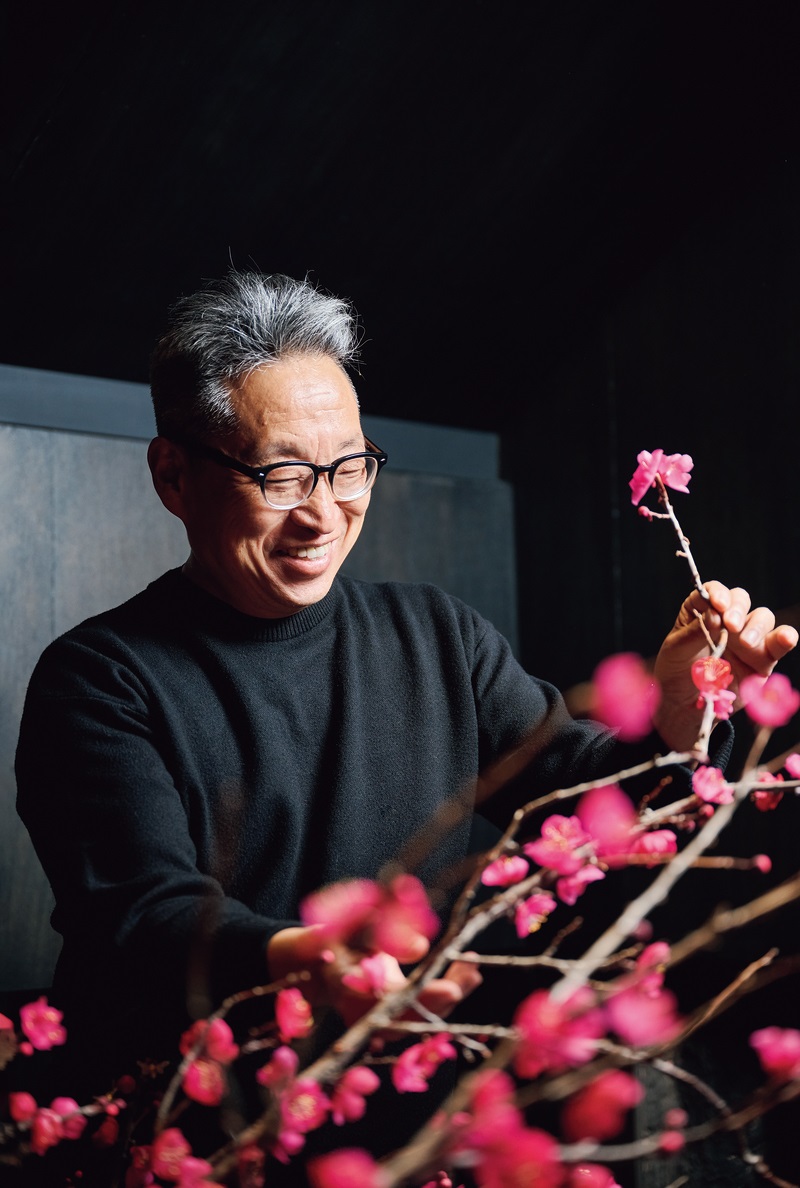
궁중채화는 염색, 다듬이질, 마름질, 인두질 등 숱한 손놀림을 거쳐야 비로소 꽃 한 송이가 완성된다. 궁중채화 이수자 최성우는 정교한 수작업 덕분에 자연 그대로의 꽃을 구현할 수 있다고 말한다. Each royal silk flower is produced through a long series of manual procedures, including dyeing, pounding, cutting, and ironing. Choi Sung-woo, a certified trainee in the traditional craft, believes it is the meticulous handiwork that makes the flowers so closely resemble their natural counterparts. ⓒ 한정현(Han Jung-hyun, 韓鼎鉉)
통의동(通義洞) 길은 경복궁 서문(西門)인 영추문(迎秋門)을 마주 보고 있다. 이곳을 걷다 보면 현대식 건물 사이로 2층짜리 낡은 건물이 눈에 띈다. 옛날 형식 그대로인 간판에는 ‘보안여관’이라는 상호가 적혀 있다. 1936년 생긴 이 숙박업소는 2004년까지 운영되다가 경영난으로 문을 닫은 이후에는 그대로 방치되었다. 2000년대 들어서면서 통의동 주변 일대는 도시 개발이라는 명분으로 낡은 건물이 부수어지고 새것이 들어서기 시작했다. 보안여관도 사라질 운명에 처했지만, 이곳을 인수한 최성우 대표는 더 이상 사람이 머물 수 없는 공간을 문화예술이 숨 쉬는 전시 공간으로 탈바꿈시켰다.
Walking the streets of Tongui-dong, a neighborhood situated across the road from Yeongchu Gate, the west gate of Gyeongbok Palace, one may encounter an old two-story building nestled among more modern structures. A weathered, old-fashioned signboard bears the name “Boan Yeogwan” (Boan Inn). Founded in 1936, this inn was a home to many writers and artists over the years and welcomed guests until 2004, when it closed its doors due to financial difficulties. In the early 2000s, the neighborhood underwent rapid urban development, leading to the gradual demolition of many old buildings and the emergence of new ones in their place. The abandoned Boan Yeogwan would have shared a similar fate if not for Choi Sung-woo, who, in 2007, transformed the by then uninhabitable building into an arts and cultural space that now pulsates with vibrant energy.
도심 한복판에서 옛 모습을 간직하며 살아남은 건물의 울림은 의외로 컸다. 보안여관은 과거를 현재로 소환해 새로운 가치를 보여 주었고, 복합문화공간으로서 새로운 트렌드를 이끌었다. 최 대표가 오늘날 통의동을 비롯한 서촌 일대의 부흥을 견인한 문화 기획자로 인정받는 이유다.
Exuding vintage charm in the heart of modern Seoul, the building resonated with visitors and passersby to an extent that completely surpassed his expectations. It demonstrated the renewed significance of the past, and Choi, as the project’s CEO, gained recognition as a cultural planner instrumental to the revitalization of the Seochon area, also known as Seoul’s West Village.
궁중채화의 복원 - RESTORATION OF ROYAL SILK FLOWERS
국가무형문화재 궁중채화 이수자인 최 대표의 작업실은 보안여관 바로 옆에 붙어 있는 신관 4층에 자리한다. 그의 어머니는 전승이 끊어지다시피 했던 궁중채화를 되살려 낸 황수로 장인이다. 한 개인의 집념이 일제 강점기를 거치면서 자칫 사라질 뻔했던 문화유산을 되살려 냈다. 2013년 궁중채화가 국가무형문화재 종목으로 채택될 때 황 장인이 첫 번째 기능보유자가 된 이유다.
With a workshop on the fourth floor of the modern building to the left of Boan Yeogwan, Choi is also a certified trainee in the craft of royal silk flower making. His mother, Hwang Suro, is a master artisan who is credited with the revival of this traditional craft, which was almost lost after the Japanese occupation period. In recognition of her contribution, she was named the first heritage holder when the craft was designated National Intangible Cultural Heritage No. 124 in 2013.
채화는 비단이나 모시 등으로 만든 꽃을 말하며, 궁중에서 왕실 연회나 주요 행사에 사용되던 것을 궁중채화라 한다. 궁궐에서는 항아리에 꽂아 어좌를 장식하는 준화(樽花), 연회 참석자들의 머리에 꽂는 잠화(簪花), 잔칫상에 올리는 상화(床花) 등으로 구분하여 사용했다. 조선 시대 각종 행사를 정리해 기록한 의궤(儀軌)에 보면, 왕의 어좌 좌우로 홍벽도화준(紅碧桃花樽) 한 쌍과 꽃으로 꾸민 무대인 지당판(池塘板) 등이 그려져 있고, 연회에 참가한 이들은 모두 왕이 하사한 홍도화(紅桃花)를 머리에 꽂고 있다.
Chaehwa were artificial flowers crafted from silk or ramie fabrics that were used during the Joseon Dynasty. Those used for court banquets and royal ceremonies, called gungjung chaehwa, were broadly categorized into three types: junhwa, vases of flowers decorating the throne; jamhwa, flowery headpieces worn by banquet attendees; and sanghwa, banquet table centerpieces. Records documenting significant ceremonies and rites of the royal family, known as Royal Protocols of the Joseon Dynasty (Uigwe), feature illustrations depicting banquet scenes embellished with different kinds of royal silk flowers. Hongbyeok dohwajun, large vases with red and white silk flowers modeled after peach blossoms, sit flanking the throne. Jidangpan, a wooden platform recreating a lotus pond, is adorned with an array of silk lotus flowers. Notably, the head of every banquet attendee is adorned with red peach flowers bestowed by the king.
문헌에는 꽃의 종류와 크기, 만드는 과정, 개수, 비용 등이 낱낱이 기록돼 있다. 정조(재위 1776~1799)는 1795년 어머니 혜경궁 홍씨의 회갑을 맞아 8일 동안 성대한 잔치를 열었는데, 이를 기록한 『원행을묘정리의궤(園幸乙卯整理儀軌)』에는 채화 1만 1,919송이가 사용됐다고 기록되어 있다. 채화가 유물로 전하는 것은 없지만, 황 장인은 이러한 문헌들을 교과서 삼아 복원에 성공할 수 있었다.
Historical literature provides detailed information on the types, sizes, production processes, quantities, and costs of the flowers. In 1795, King Jeongjo (r. 1776–1800) held a magnificent eight-day banquet to celebrate the 60th birthday of his mother, Lady Hyegyeong. A comprehensive account of the event, entitled Records of King Jeongjo’s Procession to the Tomb of Crown Prince Sado in Eulmyo Year (Wonhaeng eulmyo jeongni uigwe), notes that 11,919 bouquets of royal silk flowers were used for the banquet. While none of these fabric flowers have survived, Hwang managed to recreate them using the historical documents as a guide.
채화는 염색과 조립, 설치의 과정을 거쳐 완성된다. 우선 꽃으로 만들기에 적합한 비단을 홍화(紅花), 치자(梔子) 등 자연에서 채취한 염료로 염색하여 풀을 먹인다. 그런 다음 홍두깨로 두드려 윤기와 탄력을 더한다. 그러고 나서 꽃잎을 마름질한 다음 불에 달군 인두에 밀랍을 묻혀, 꽃이 피어 있는 모양새대로 하나씩 다려서 형태를 만든다. 여기에 송홧가루를 묻힌 꽃술을 끼워 고정한다. 준비한 가지에 완성한 꽃들을 잎, 꽃봉오리와 함께 설치하면 끝이다. 채화는 염색부터 마무리까지 손으로만 작업하기 때문에 한 종류의 꽃이라 하더라도 똑같은 빛깔과 형태가 나오지 않는다. 이것이 시중에서 판매하는, 공장에서 기계로 찍어 내 만든 조화(造花)와 다른 점이다.
The process of creating royal silk flowers involves dyeing, assembly, and installation. First, silk cloths selected for flower-making are dyed using natural pigments such as safflower and gardenia seeds. The cloths are then starched and beaten with a wooden roller to enhance their gloss and elasticity. Then, they are cut into petal shapes, which are smoothed and shaped with beeswax on a heated spatula iron. After this, the petals are arranged in the shape of a blooming flower, and stamens and pistils coated with pine pollen are inserted. The final step involves arranging the completed flowers, together with leaves and buds, on stems and branches. Since the entire process is done by hand, even flowers of the same type may vary in color and form. The individuality and variation of the flowers is what sets them apart from factory-made versions.
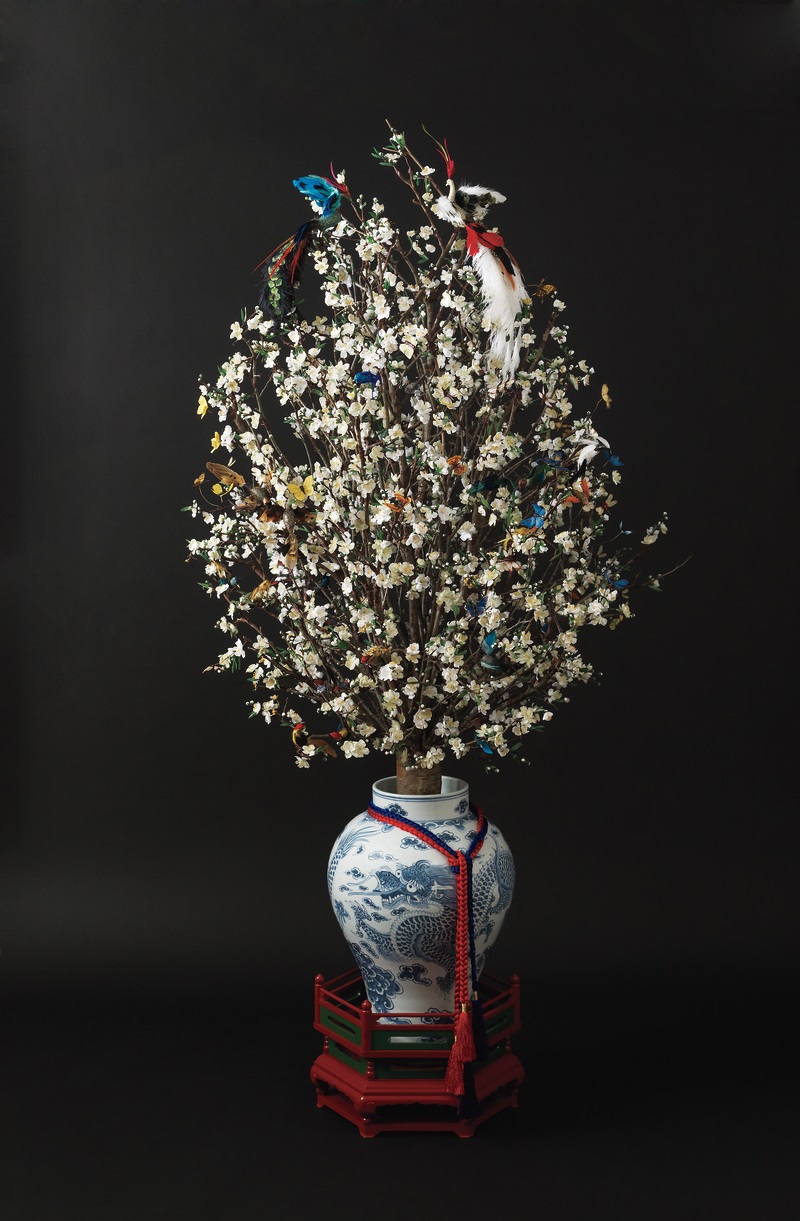
홍벽도화준(紅碧桃花樽)은 궁중 의례 시 정전(正殿)을 아름답게 장식하는 용도로 쓰였는데, 붉은색과 흰색의 복숭아꽃을 어좌 좌우에 각각 하나씩 배치했다. 높이가 3m에 이르러 화려하면서도 장엄한 느낌을 준다. Hongbyeok dohwajun, large vases with red and white silk flowers modeled after peach blossoms, were placed on either side of the throne to decorate the audience hall. This three-meter-tall vase, filled with white silk flowers, exudes a sense of magnificence and dignity. 한국궁중꽃박물관 제공 - Courtesy of the Korean Royal Silk Flower Museum
황수로 장인이 1829년 창경궁에서 열렸던 잔치에 쓰인 지당판(池塘板)을 재현한 작품이다. 지당판은 궁중 무용이 펼쳐지는 무대를 꾸몄던 도구로, 받침대 위로 좌우에 연꽃을 놓고 그 주변에 모란 화병 7개를 배치했다. Master artisan Hwang Suro crafted this jidangpan, a recreation of a lotus pond, placing two lotus blossoms side by side, surrounded by seven vases of peony flowers, on a wooden platform. This model is based on platforms used to decorate the stage for court dances at the banquet held at Changgyeong Palace in 1829. 한국궁중꽃박물관 제공 - Courtesy of the Korean Royal Silk Flower Museum
어머니의 제자가 되다 - BECOMING HIS MOTHER’S PUPIL
최 대표는 1960년 황수로 장인의 3남 중 장남으로 태어났다. 그는 외가인 부산 초량동(草梁洞) 적산가옥에서 초중고 시절을 보냈다. 그의 외조부는 국내 최초로 코르덴이라는 직물을 생산한 태창(泰昌)기업 창업자 황래성(Hwang Rae-sung, 黃來性) 회장이고, 아버지는 도쿄대 출신의 농학자로 외조부의 뒤를 이어 회장을 지낸 최위경(Choi Wee-kyung, 崔胃卿)이다.
Choi was born in 1960 as the eldest of Hwang Suro’s three sons. He spent his childhood and school years living in his maternal grandparents’ home, a house in Busan’s Choryang-dong built during the Japanese occupation period. His maternal grandfather, Hwang Rae-sung, founded Taechang Corporation, a textile company that was the first in Korea to produce corduroy, while his own father, Choi Wee-kyung, was a Tokyo University-educated agricultural scientist who later succeeded his father-in-law as the company’s chairman.
"어머니가 무남독녀라 저는 거의 외조부모님 손에서 자라다시피 했어요. 깐깐하기로 소문난 제 어머니도 꼼짝하지 못할 만큼 엄했던 외할아버지였지만, 제겐 자상한 분이셨죠. 제가 서양화를 전공했지만 문화 경영에 관심을 두게 된 것은 외할아버지의 영향이 컸다고 생각합니다.”
“Since my mother was the only child, I practically grew up under my maternal grandparents’ care,” Choi says, describing his upbringing. “My maternal grandfather was kind to me, even though he was usually so stern that even my mother, who was known for her strictness, was afraid of him. I believe it was my grandfather’s influence that led me to develop an interest in cultural management after I majored in Western painting at university.”
정치적으로 혼란스러웠던 1980년대 초, 그는 연극과 마당극 등을 통해 현실 참여 활동을 하며 대학 생활 대부분을 보냈다. 그러다가 프랑스 유학길에 올랐다. 파리 제1대학교에서 미술사로 박사 과정을 마치고, 프랑스 문화부 연구 단원으로 뽑혀 2년간 연수 기회를 가졌다.
In the early 1980s, amidst the political turmoil in the wake of the Gwangju Uprising, Choi spent most of his college years engaged in social activism through theater and traditional performances, after which he went to France to continue his studies. Having completed a doctoral program in art history at Université Paris 1 Panthéon-Sorbonne, he spent two years working as a research fellow at the French Ministry of Culture.
"13개국에서 한 명씩 뽑아 유럽 최고의 문화를 경험할 수 있게 지원해 주는 프로그램이었죠. 일반인들은 접근하기 어려운 박물관 수장고와 시스템들을 원하는 대로 볼 수 있었습니다. 유럽의 여러 축제들을 비롯해 문화 기관들을 방문하고 연구해 볼 기회도 가졌습니다. 이때 전통적 가치를 동시대인의 삶에 융합하는 문화 경영에 눈을 뜨게 됐죠.”
Choi explains, “I participated in a program where one researcher each from 13 different countries was selected to experience the quintessence of European culture. We were given access to various museum collections and systems, a rare opportunity not usually offered to the general public. This experience opened my eyes to the cultural management that integrates traditional values into contemporary life.”
1993년 그는 7년 반의 유학 생활을 마치고 한국으로 돌아왔지만, 집안 사정으로 가업을 떠맡게 됐다. 몸에 맞지 않은 옷을 입은 지 10여 년 만에 그는 보안여관으로 비로소 제자리를 찾았고, 이 무렵 눈에 들어온 것이 궁중채화였다.
After seven and a half years of studying in France, Choi returned to Korea in 1993. Circumstances dictated that he takes over the family business, a role in which he then spent almost a decade feeling out of place. He finally found his calling when he took over Boan Yeogwan. It was also around this time that the art of royal silk flower making caught his attention.
"2007년 뉴욕 유엔 본부에서 열린 한국공예대전에 어머니를 도와 처음으로 화준(花樽, 꽃항아리)을 출품했을 때였어요. 방문객들이 사진을 찍겠다고 저희 쪽으로 일제히 몰려드는 거예요. 꽃은 어떤 설명도 필요 없는 인류 공통의 언어였던 거죠.” 궁중채화에 대한 열렬한 반응은 2013년 밀라노 한국공예대전에서도 이어졌다. 어려서부터 보고 자라서 채화가 익숙하긴 했지만, 그에게 계승은 전혀 다른 문제였다.
“In 2007, when the exhibition Traditional Korean Crafts was held at the United Nations headquarters in New York, I assisted my mother in exhibiting vases of royal silk flowers for the first time. I saw visitors flocking to take pictures of our exhibits and realized that flowers are a universal language that needs no explanation,” Choi says. Royal silk flowers received a similarly enthusiastic acclaim at a 2013 exhibition in Milan entitled Constancy and Change in Korean Traditional Craft.
"어머니에게 채화를 배우러 온 사람들이 이수자가 되어도 수요가 거의 없으니, 결국에는 모두 떠나곤 했죠. 그래서 제가 전수받을 수밖에 없었는데, ‘왜 내가 해야 하지?’라는 의문이 떠나지 않았어요. 그러다가 2014년 < 아름다운 궁중채화전(Beautiful Royal Silk Flower)>을 준비하면서 그제야 채화의 아름다움에 눈을 뜨게 됐죠.”
Having watched his mother work, Choi was familiar with the handicraft from an early age, but inheriting her legacy was an entirely different proposition. “Those who learned the craft from my mother eventually left, even after they became certified trainees, because demand is inconsistent,” Choi explains. “I had no choice but to continue her legacy, but I couldn’t shake off the question ‘Why should I do this?’ Then, in 2014, while preparing for the exhibition Beautiful Royal Silk Flowers, I was truly awakened to the beauty of royal silk flowers.”
국립고궁박물관에서 열렸던 이 전시는 순조(재위 1800~1834)의 40세 생일과 등극 30주년을 기념하기 위해 1829년 창경궁에서 열렸던 당시의 잔치를 재현해 화제가 됐다. 이후 그는 염색부터 시작해 황 장인에게 본격적으로 전수를 받았고, 2019년 이수자로 인정받았다. 황 장인이 사재를 털어 경상남도 양산(梁山)시에 건립 중이던 한국궁중꽃박물관이 같은 해 완공돼 문을 열었다. 그는 이듬해 궁중채화의 교육과 발전을 위해 ‘궁중채화서울랩’을 열었고, 현재 어머니의 뒤를 이어 한국궁중꽃박물관장을 겸하고 있다.
Held at the National Palace Museum of Korea, the exhibition was acclaimed for its recreation of the 1829 banquet held at Changgyeong Palace in celebration of the 40th birthday of King Sunjo and the 30th anniversary of his enthronement. Afterwards, Choi dedicated himself to formal training under his mother until he was officially recognized as a certified trainee in 2019. In the same year, the Korean Royal Silk Flower Museum opened its doors. The museum was constructed in Yangsan in South Gyeongsang Province, at her own expense. In 2020, Choi opened the Royal Silk Flower Seoul Lab to develop and educate others on the traditional craft. He currently runs the lab while also serving as the director of the Yangsan museum, having succeeded his mother.
"궁중꽃박물관이 변하지 않아야 할 전통적 가치를 보존한다면, 궁중채화서울랩은 현대적 확장을 모색하고 실험하기 위한 연구소라고 할 수 있습니다.” “While the museum seeks to preserve traditional values that should not change, the lab is dedicated to promoting and experimenting with broader modern applications of the tradition,” Choi explains.
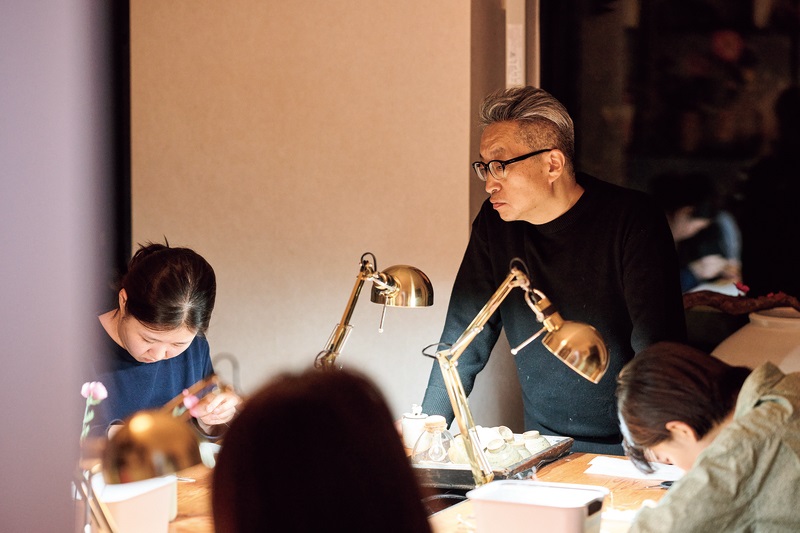
궁중채화서울랩(Royal Silk Flower Seoul Lab)에서 채화 제작을 가르치고 있는 최성우 이수자. 그는 궁중채화의 전통적 가치가 동시대에 공명(共鳴)하기 위해서는 그것의 확장 가능성을 끊임없이 모색해야 한다고 생각한다. 그 일환으로 궁중채화서울랩을 창설했다. Choi teaches at the Royal Silk Flower Seoul Lab, which he established in the belief that the traditional craft should be integrated into contemporary life. ⓒ 한정현
현대적 조형물 - MODERN INSTALLATIONS
최 대표는 2023년 9월부터 11월까지 서울공예박물관에서 진행된 < 공예 다이얼로그 > 전시에서 전통적인 홍벽도화준과 함께 채화를 현대적인 방식으로 해석한 작품도 보여 주었다.
Held at the Seoul Museum of Craft Art from September to November 2023, Choi’s exhibition Dialogue presented modern interpretations of royal silk flowers along with traditional recreations of red and white silk flowers in vases.
"궁중채화의 조형적 아름다움은 그 자체로 자연이 선사하는 아날로그의 극치라고 생각합니다. 채화의 전통적 가치가 오늘날에도 이어지기 위해서는 동시대의 기법, 수단, 방법이 활용돼야 합니다. 그리고 이 시대의 언어로 표현된 창조적 조형물이 궁중채화의 전통성과 함께 구현되어야 하죠." 채화가 우리 시대에 어떻게 쓰일 것인가의 문제는 이수자이자 문화 기획자로서 그가 풀어가야 할 과제이다.
Describing his work, Choi says, “I believe the sculptural beauty of royal silk flower installations is, in itself, one of the greatest analog representations of the world of nature. For traditional royal silk flowers to appeal to contemporary tastes, it is essential to use modern techniques, means, and methods.” As both a certified trainee and cultural planner, Choi is now focused on addressing the question of how to use this traditional handicraft in the present day.
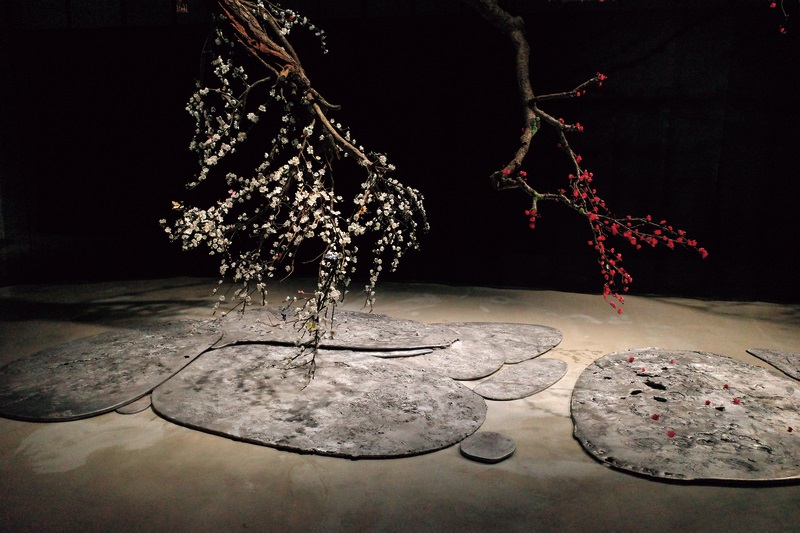
2023년 서울공예박물관에서 진행된 < 공예 다이얼로그 > 전시 모습. 최 이수자와 궁중채화서울랩 작가들이 함께 제작했으며, 궁중채화를 현대적으로 해석한 작품이다. A scene from the exhibition Dialogue, held at the Seoul Museum of Craft Art in 2023. Choi collaborated with artists from the Royal Silk Flower Seoul Lab to create this contemporary interpretation of the traditional craft. 한국궁중꽃박물관 제공 - Courtesy of the Korean Royal Silk Flower Museum
이기숙(Lee Gi-sook, 李基淑) 작가
Lee Gi-sook Writer
%EC%9D%84%20%EC%9E%AC%ED%98%84%ED%95%9C%20%EC%9E%91%ED%92%88%EC%9D%B4%EB%8B%A4.jpg)
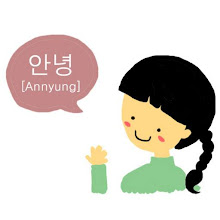


.jpg)





0 comments: